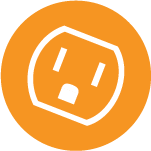Where are GFCI Breakers Required?
A GFCI circuit breaker is an electrical device that installs in the breaker box of residential or commercial spaces. GFCI breakers are most common when all outlets on a circuit require protection from a ground fault circuit interrupter.
Knowing where to place the breaker is very important. This blog discusses the best places to install a GFCI circuit breaker.
What is a GFCI Circuit Breaker?
As said above, a GFCI breaker, or GFI breaker, installs into a home service panel, also known as a breaker box. This type of circuit breaker provides GFCI protection for all the outlets connected.
Installing a GFI breaker is another option instead of having to place multiple GFCI receptacles in specific locations. By having GFCI protection, the homeowner gains protection from potential shocks during circuit failures.
GFCI protection is also great for preventing electrocution. GFCI’s cut off power when it senses a difference in electric current. This stops unintended electrical flow from shocking someone.
Recommended Products
Where are GFCI Breakers Required?
The National Electrical Code (NEC) requires GFCI protection in areas where water and electricity might come in contact. These areas include bathrooms, garages, and kitchens. Other areas include:
- Laundry Areas
- Basements
- Outdoor spaces
- Swimming Pools and Hot Tubs
Check local codes and regulations to go along with the NEC requirements to ensure you are up to date.
Following the NEC requirements, you can locate most ground fault breakers in breaker panels. They can control the rest of the outlets that connect to that breaker. They are also great for areas where the risk of electric shock is high from water or moisture.
Are GFCI Breakers and GFCI Receptacles Required in the Same Locations?
While GFCI breakers and receptacles can operate in the same room, it is best to choose one or the other for the circuit. Installing both on the circuit can lead to electrical system issues as well as potential tripping.
Before choosing which type to install, it is important to know the differences and preferred locations of each.
GFCI Circuit Breakers
- Install in the main breaker panel
- Can turn the power on or off to the entire electrical system
- Protect many outlets and lights at once
- More appealing when protecting an entire circuit or dealing with wiring scenarios
GFCI Receptacles
- Install each individual receptacle into the outlets
- Place them in areas including bathrooms, garages, and outdoor areas
- Ability to reset at the receptacle if tripping occurs
- Preferred in places where individual outlets need protection
When choosing between the two GFCI protectors, determine which would work the best for each situation. For example, GFCI receptacles are great for protecting a single device. GFCI breakers differ because they can protect multiple locations at once.
Another example is the ease of installation for GFCI receptacles. Since the receptacles are smaller, they are easier to install than GFCI breakers. GFCI receptacles also have straightforward instructions, unlike circuit breakers.
GFCI breakers tend to be thinner in size, which helps to place them in regular boxes while receptacles are larger. This means the receptacles will have to go in a bigger box which can increase costs for manufacturers.
Why is it important to upgrade an electrical system?
If you are residing in a home with older electrical systems, we encourage you to upgrade to modern protection devices. Whether they are GFI breakers or other GFCI protection devices, it is best to upgrade. Upgrading your electrical system helps prevent electrical shock and fires. Upgrading electrical systems also keeps your home or workspace up to code.
Some important pointers to help upgrade and keep the electrical system are:
- Placing GFCI protection to circuits near damp areas
- Hiring a licensed electrician to check the electrical system
- Installing GFCI switches and outlets in required locations
- Have a peace of mind by testing the current and future GFCIs to ensure they are working properly
We strongly encourage licensed professionals to perform any electrical work. Licensed professionals have the knowledge necessary to follow safety and code compliance guidelines.
In Summary
GFCI breakers are required in damp areas where the threat is understood. By having a better understanding of where they can go, you can prevent electrical shock from occurring. Shop GFCI products at HomElectrical!
How to Reset GFCI Breaker?
Resetting a GFCI breaker can be an easy task. Below are the steps to reset the tripped circuit.
Check the box: Locate the panel. It is usually in the garage, on the side of the home, or in the basement.
Open the service box and find the tripped breaker: The tripped breaker will be turned to the "OFF" position. To reset the breaker, you will need to ensure it is fully off. Once the breaker is fully off, you can flip the breaker to the "ON" position and the power should come back on.
Recommended Reading
Ground fault circuit interrupter devices protect against ground faults in the home. GFCI receptacles and GFCI circuit breakers have similar functions, but different benefits depending on your electrical safety needs.
GFCI breakers and receptacles keep you safe from electric shocks and fires. Use a GFCI outlet in areas with a high chance of water coming into contact with the electrical current, such as a bathroom or kitchen.
Explore the crucial aspects of GFCI outlets with our essential guide. From understanding their function to practical tips, this guide is your go-to resource for navigating the world of GFCI outlets.
When choosing the type of electrical outlet you will need, consider the type of devices you plan to plug in and the safety. Options include a single outlet, duplex outlet, GFCI outlet, USB outlet, smart outlet, and a light switch & electrical outlet combo.
Recommended Products
Receive special deals and more, right to your inbox
Receive special deals and more, right to your inbox






.jpg&w=500&q=75)

